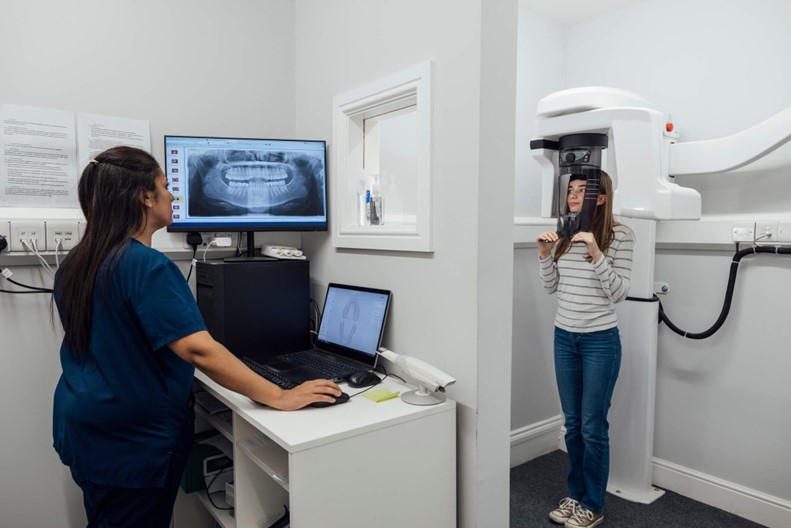How 3D Imaging Is Changing Modern Dentistry
Going to the dentist looks different today than it did even a decade ago. Instead of relying on traditional X-rays and manual impressions, modern dental teams have access to advanced tools that make care more accurate, efficient, and comfortable. One of the most impressive innovations leading this change is 3D dental imaging. This technology has revolutionized the way dentists diagnose conditions, plan treatments, and communicate with patients for a more comprehensive and positive experience all around.

What Is 3D Dental Imaging?
For years, dentists depended on two-dimensional X-rays to evaluate teeth and jaws. These images provided useful information, but they came with limitations, such as a tendency to flatten complex structures or conceal hidden details.
3D dental imaging eliminates these blind spots. Using cone beam computed tomography (CBCT), dentists can now capture a three-dimensional model of your mouth that includes teeth, bone, nerves, and soft tissue. Instead of a single flat snapshot, the result is a virtual model that can be rotated, zoomed in on, and studied from every angle.
The process is quick and comfortable. A full scan usually takes less than a minute and requires no special preparation. Patients sit or stand still while a scanner circles around the head, producing crystal-clear images ready for review almost immediately.
Dental Technology Benefits for Every Patient
Technological advances are only meaningful if they make life easier for patients. That’s exactly what digital dentistry does. By removing uncertainty from the equation, patients can trust the plan, and dentists can deliver the best possible outcome. Here’s what to expect:
- Earlier detection of problems: Tiny infections, cysts, or bone loss can be identified and treated before they cause lasting damage.
- More predictable treatment plans: Precise images allow dentists to plan procedures with greater confidence.
- Improved safety: Seeing the exact location of nerves and sinuses reduces risks during delicate procedures.
- Patient confidence: When patients can see detailed scans on-screen, they find it easier to understand recommendations and feel more comfortable moving forward.
Where 3D Imaging Improves Dental Care
Some procedures demand a higher level of accuracy. Here’s where 3D imaging shines:
- Implant dentistry: Successful implant placement depends on precise positioning within the jawbone. A 3D scan shows the available bone structure and highlights nearby nerves, so the dentist can place implants with exceptional accuracy.
- Orthodontics: Whether planning for metal braces or clear aligners, orthodontists benefit from a three-dimensional view of the teeth and jaw.
- TMJ evaluations: Temporomandibular joint disorders can be complex to diagnose. Detailed scans allow the dentist to analyze the joint structure and identify potential causes of pain.
- Airway assessments: Sleep apnea and other breathing concerns are often linked to oral and jaw structures. Digital dentistry makes these evaluations clearer and more comprehensive.
- Complex extractions: Removing impacted wisdom teeth is safer when the dentist knows the exact location of tooth roots and surrounding nerves.
Advanced Dental Tools Prioritize Comfort
Technology isn’t just about results. It also makes the process more comfortable. One of the clearest examples is the shift from physical impressions to digital scans.
Many patients remember the old trays filled with thick, gooey material that often triggered the gag reflex and required multiple attempts. Digital scanning has substituted that experience with a simple handheld device that captures a complete model of the mouth in minutes.
These scans are highly accurate and useful for planning everything from crowns and bridges to custom mouthguards and orthodontic aligners. Digital impressions mean minimal errors, faster results, and fewer return visits. They give patients a glimpse of how their teeth will appear once treatment is complete, providing a clear picture of the path ahead.
Why Traditional Tools Haven’t Disappeared
Even though 3D technology has taken dentistry to the next level, traditional imaging methods are still valuable in some instances. For example, quick, low-radiation 2D X-rays remain a smart choice for routine exams, cavity detection, and monitoring ongoing issues. Photos taken inside the mouth also show patients what the dentist sees to support conversations about treatment.
The real advantage comes from combining both methods. Dentists can choose the right tool for the job to deliver efficient, safe, and thorough care.
Experience Dental Technology Benefits for Yourself
S&L Dental has decades of experience enhancing oral health and transforming smiles for families and individuals across the Scottsdale area. Our team believes advanced dental tools should make patients feel comfortable and cared for, and that’s exactly what 3D imaging helps us achieve. We use this innovation to support high-quality care and create life-changing experiences for patients of all ages.
Discover the difference modern dentistry can make for your smile. Contact us today to schedule an appointment at our Paradise Valley office.
